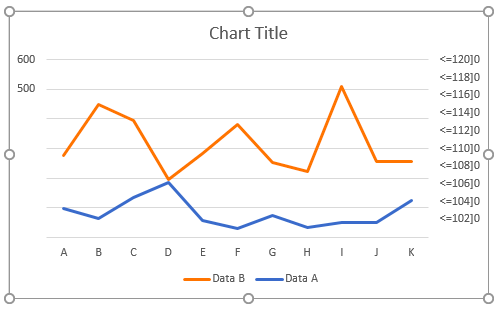

In the opening Format Data Series pane/dialog box, check the Secondary Axis option, and then close the pane or dialog box.Ĥ. In the chart, right click the below series, and then select the Format Data Series from the right-clicking menu.ģ. Select the source data, and add a line chart with clicking the Insert Line or Area Chart (or Line)> Line on the Insert tab.Ģ. Why? Because doing so makes no sense in the case of those types of charts.Supposing there are two data series in the source data as below screen shot shown, we can easily add a chart and break the chart axis with adding a secondary axis in the chart.

If the chart doesn't have an axis (such as a pie chart) or the chart is primarily for plotting numbers (such as with an XY chart), then you may not be able to tell Excel to treat the axis as text. You should note that your ability to modify the Axis Type setting depends on the type of chart you are creating. Thus, if you want to change the way the dates are displayed in the chart, you'll need to reformat your source data for the desired appearance. In addition, the dates on the axis should be displayed exactly as they appear in the worksheet data. This means that you won't get any phantom dates in the date range displayed in the chart. The Axis Options on the Format Axis task pane.Īt this point, Excel should redraw your chart and treat your dates as text values, even though they really are dates.

You could, of course, change the formatting pattern for the date to anything you want, as described in other ExcelTips. If you decide to go the helper route, you could use a formula such as the following: (Excel doesn't recognize text values as dates, and therefore doesn't do the whole earliest-to-latest range thing.) You could do this by actually converting the date column or row into text or by adding a helper column or row that contains the dates as text representations.

First of all, you can convert your original dates into text values. The solution to this is to overcome the automatic parsing done by Excel as it converts the data in your worksheet into a chart. That means that it includes data points in the range that may not really exist in the original data-such as the weekends that Scott mentions. If it determines that the data in a particular column or row represents dates, it looks at the earliest date in the range and the latest date in the range and then uses that as the range for the axis. When you convert your data into a chart, Excel tries to make sense of the data it is charting. These dates are not in the original data and he cannot seem to get rid of them so that only the data in the table is shown in the chart.īelieve it or not, this behavior is by design. (The data contains no entries for weekends.) When Scott graphs the data using the dates as the horizontal axis, Excel inserts the weekend dates with no data points. The data is entered by date which only reflects weekdays. Scott has a set of data by date that is used for a graph.


 0 kommentar(er)
0 kommentar(er)
